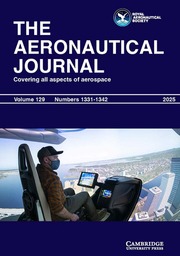Article contents
Aircraft flight characteristics inconditions of windshear and icing
Published online by Cambridge University Press: 03 February 2016
Abstract
Complex weather conditions, especially windshear andicing encounter, have severe effects on aircraftflight safety. The effect of low-altitude windshearand ice accretion on aircraft performance andcontrol has been studied in this paper. With theemployment of a windshear model and nonlinearinverse dynamics (NID) method, a low-altitudewindshear penetration flight control law isdesigned. The effect of ice accretion was modeled onthe stability and control of an aircraft. Severalicing parameters are imported to the smalldisturbance flight dynamics model to calculate thechange of performance, stability and controlderivatives between clean and iced aircraft. Thesederivatives were used to calculate the elevator, theaileron and the rudder step responses to investigatethe icing effect.
The simulation results indicate that the NID controllogic works effectively in the trajectory control ofthe aircraft during the penetration of windshear.The method used to study the effect of ice accretionon aircraft is valid and it can provide data forreal-time calculation for icing encounter.
Information
- Type
- Research Article
- Information
- Copyright
- Copyright © Royal Aeronautical Society 2007
References
- 6
- Cited by

